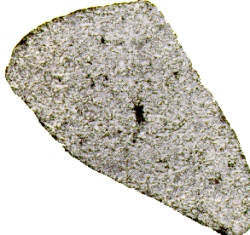
February Editorial
Martian meteorites

February Editorial
Martian meteorites
|
|
Although no spacecraft from NASA or anywhere else has ever returned to earth with Martian rock samples, we know quite a bit about the planetís geology. Spacecraft orbiting Mars have sent back pictures of exposed strata and rovers on the planet have sent back their analyzes of isotopic composition and the composition of atmospheric gases. However, there is nothing like having an actual Martian rock in a laboratory right here on Earth. That's why Martian meteorites are so handy. During meteorite showers a few rocks from the Red Planet have landed on Earth. But to say that they are rare is putting it mildly. Out of the 53,000 thousand meteorites which have been found on Earth only about 100 are Martian. |
|
|
It may be asked why any meteorites at all come from Mars. The answer is because Mars has a solid surface, as does the Earth. Therefore when Mars gets hit by something large - such as an asteroid, some of the debris thrown up by the impact is hurled fast and far enough to escape the planet's gravitational pull. In the distant past an asteroid, or even a comet, struck Mars in this way, throwing rocks from the Martian planetary crust into space. Over time, some of these rocks have landed on Earth. The most recent of such is a shregottite class of meteorite, a approximately 7kg stone named Tissint which fell in Morocco in July 2011. (Shergottites are basaltic to lherzolitic igneous meteroites from Mars, named after Shergotty, India, where such rocks fell in 1865) Tissint is the first confirmed martian meteorite that has been found in the last 50 years and it is only the fifth time that a newly-fallen martian rock has been confirmed by expert chemical analysis. The previous known Martian meteorites fell in 1815 in France, 1865 in India (as mentioned above), 1911 in Egypt and 1962 in Nigeria. A closer look at the dates shows that these falls happen almost exactly every 50 years. Expect the next delivery of Martian rock in 2062. The arrival of Tissint was witnessed by Moroccan nomads. At about 2:00 a.m. local time on July 18 2011, they were startled by sonic booms and a fireball that one witness said lit the night sky with a yellow and then a green glow, before breaking into pieces and disappearing into the remote desert. Military personnel who have an interest in objects entering (or mainly missiles re-entering) the atmosphere tracked the fall, and in October 2011 a ground expedition found black, heat-scorched stones near the Moroccan village of Tissint. In January 2012 NASA confirmed that these rocks indeed of Martian origin. The biggest rock weighed nearly one kilogram - two pounds - but the total original meteorite (officially named Tissint by the International Society for Meteoritics and Planetary Science) weighed in at 6.8 kilograms - 15 pounds. Roughly 75% of Martian meteorites are shergottities. These are igneous rocks high in magnesium and iron. One of the puzzling things them is that they seem to be very young rocks (crystallized only about 180 million years ago). This makes them very young when compared with the age of Mars itself. This paradox is still hotly debated amongst scientists. What makes Tissint particularly important is its recent arrival. As Christopher Herd, a professor of Earth & Atmospheric Sciences at the University of Alberta in Canada, who headed the committee of scientists that verified the meteorites came from Mars, explains: "Compared to previous meteorites known to be of Martian origin, pieces of the Tissint meteor are especially good specimens because they were found shortly after landing in the Moroccan desert. ...It's really fresh. It's really glassy-looking because itís only been on the ground for a few months in a nice, dry environment. So, it hasn't been affected in a big way by rain or even wind - that sort of thing that does occasionally happen in the desert." Most other rocks from Mars are tainted with Earth materials because they sat around exposed on the Earth's surface for a long time. Although the Tissint rocks are still probably contaminated to some degree, they have been on Earth just a few months and are therefore much purer. Which means that anything uncovered during analysis of Tissint rocks is more likely to be Martian than terrestial contamination. You can see one of the Tissint rock in this video: | |
| _______________________________ | ||||
| Home | | | Shopping | | | Database |
© Biscuit Software 2004-2015
All rights reserved